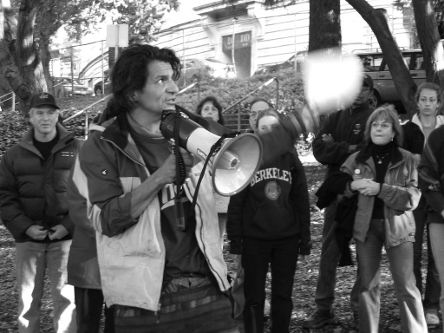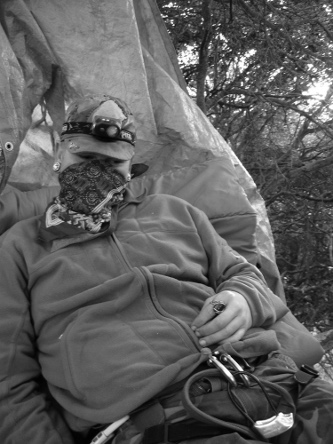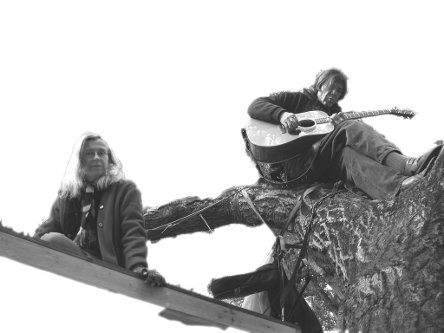|
Environmental Justice
|
|
Who Speaks For the Trees?
People Unite to Save a Sacred Oak Grove in Berkeley Printable Version: Download
as PDF
Is nature sacred? Who has the legitimate right to declare it as such? These questions lie at the heart of a currently unfolding, multifaceted conflict over UC Berkeley's plans to cut down a much-beloved grove of oak trees in order to construct an underground athletic training facility adjacent to the California Memorial football stadium. Following in the footsteps of Julia Butterfly Hill and Earth First! forest defense actions, the Save the Oaks Campaign has all the makings of a classic environmental struggle, including activists living for months on end in lofty tree platforms and a contentious lawsuit. The campaign's most prominent figurehead is Native American leader and mayoral candidate Zachary Running Wolf, who along with other natives and community members has declared the grove to be sacred. The campaign focuses on a broad range of issues - from respect for war veterans to the global warming crisis - revealing deep truths about how we relate to the world and why humanity stands on the brink of ecocide. What's at Stake? This "urban forest" is also cherished
because it provides a special space for the community
to relax, meditate and commune with nature. Urban forests
are known to improve the mental health, happiness and
well-being of city dwellers whose daily experiences are
dominated by a sea of concrete. The U.S. Department of
Agriculture Forest Service has published numerous reports
on the effect of urban forests on air quality, reduction
of harmful UV radiation and greenhouse gasses, and mitigation
of soil erosion. The Oak Grove is one of the last such
groves in the city's flatlands. The oaks are also considered
excellent specimens as a gene bank of native trees. Concerned with global warming, activists
state that the University's reported plans to "plant
three new trees" for each one they cut down cannot
possibly replace the loss of an urban forest or mitigate
the loss of a mature oak tree's ability to sequester CO2.
Further, they say it sets the wrong example for students
in an age of global warming. British journalist George
Monbiot warns we must cut emissions 90 percent by 2030
or face an irreversible positive feedback loop of warming
that causes more warming. (See www.monbiot.com
for more details.) The Oak Grove is adjacent to the California Memorial Stadium, which is dedicated to the memory of World War I veterans. William Lindo Jr., the son of a World War II naval combatant, sees the grove as a "cemetery without the coffins" and would view any attempt to cut the trees as akin to defacing Arlington National Cemetery. A frequent visitor to the grove, he has pledged to hug the trees if they are attacked, claiming the UCPD would have to kill him first.
From Petitions to Direct Action In fall 2006, Emma Fazio and other students
organized a rally on Sproul plaza that culminated in Buckwald's
presentation of stacks of petitions to a security guard
at the Chancellor's office. The Chancellor refused to
meet with students or community members to discuss the
matter - according to those who attempted to contact him
about it, his response was, "I only meet with people
to discuss human issues." With Cal's plans to cut down the trees set
for January 2007, a group of community activists decided
they had to do something. Early in the morning of Dec.
2, 2006, (the day of the "Big Game" between
Cal and Stanford), Running Wolf of the Black Feet tribe
and a small group of his friends descended on the Oak
Grove with the intention of occupying the threatened trees.
A young woman known as "Giggles" (most tree-sitters
use code names) managed to free climb partway up one of
the trees and stayed there for more than thirty days.
As we go to press in May 2007, over 100 activists (including
a half-dozen students) have cycled in and out of seven
different trees during the past four months, living on
small wooden platforms and hammocks known as "dream
catchers" they installed in the highest branches
of the trees. A supportive ground crew brings the tree-sitters food, water, and the basic necessities of life (hoisted up and down on ropes), empties their waste buckets, and keeps them company. Community members and organizations like Food Not Bombs have rallied to the cause and cook hot meals on a daily basis. Cop Watch supplies volunteers with video cameras to keep tabs on the UCPD, whose officers have repeatedly harassed both the regular tree-sitters and visitors to the grove, charging them with illegal lodging and trespassing. The police claim that the tree-sitters and visitors are engaged in criminal activity and an "illegal protest." In response, activists say that they are engaged in constitutionally protected free speech. Most police harassment consists of ID checks and threats to issue citations, but occasionally the police have physically assaulted activists (wounding one student, according to eyewitnesses) and made nearly a dozen arrests.Tree-sitter Major Tom, who is a citizen of the UK, has not been heard from since he was arrested a second time. His friends fear he was deported.
An Uncertain Commitment Others see things differently. Running Wolf,
whose people and land have been the victims of Euro-American
genocide and conquest for more than 500 years, relates
that in the Black Feet culture, violent resistance is
an accepted "last-resort" option. He says that
if a police officer attempts to pull him out of his redwood
tree (one of several non-oaks in the grove), he would
consider it an attack on Native America, feel threatened,
and throw the assailant out of the tree in self-defense.
He's even speculated that his publicly disclosed threat
has helped keep the trees safe, as UCPD may not wish to
risk the negative publicity and possible injury or death
that could result from a struggle 50 feet above the ground. What are the implications to a movement's ability to succeed in its stated objectives - and work to change the consciousness of humanity - if its participants do not embrace disciplined nonviolent resistance? History indicates that in such situations, all too often the violent actions of a few drown out the nonviolent efforts of others, especially in the media's eyes. (When 80,000 marchers in San Francisco peacefully protested the start of the second Iraq war and a few dozen "Black Block" protestors smashed a few windows, guess who captured the headlines and lead sentences of the newspapers?) When protestors resort to violence, the media covers the violence, but when activists maintain nonviolent discipline, the media is much more likely to cover the issues. If the Oaks Campaign is unsuccessful in the lawsuit and the struggle gets decided in the tops of trees, a lack of nonviolent discipline could seriously undermine activists' capacity to accomplish their objectives.
The Tree Tribe and the "Spaceship" According to Running Wolf, the grove has
become sacred over the past few months as a result of
the community that has arisen to defend it. He reports
that the grove is a place of healing and transformation
for individuals. Prominent tree-sitter Giggles - who recently
renamed herself "Everything" because she wants
people to see the 'big picture' - came to the Oak Grove
not to save the trees, but to save herself. She had a
profound spiritual experience during her initial 30-plus
day stint in the trees, and those who know her consider
her to have attained a heightened spiritual awareness,
or enlightenment. Chancellor Birgeneau said he disagrees with
Running Wolf on the sacred status of the grove. On a cultural
level, this is perhaps the heart of the conflict: Who
has the right to make a claim about sacredness, and how
is that claim socially understood? Another layer of sacredness
was revealed when Running Wolf and other natives announced
that the grove is an Ohlone burial ground, given that
several skeletons were removed during the adjacent stadium's
construction in the 1920s. Running Wolf and other natives bring into focus the conflict between the modern patriarchal capitalist ideology of domination and conquest, as compared to a native understanding that says everything is interconnected and trees are as worthy of respect as humans. In Ohlone tradition, trees are known as "tree people." Given that all violence begins with dehumanization, it is quite easy to see how a native culture that view trees as humans would do a much better job of protecting them than our culture, which views them all too often as an extractable resource.
Perception and Reality Although the mainstream media has dehumanized parties on both sides with stereotyped depictions of intractable opposition, the reality is not so simple. Numerous athletes who support the Oak Grove protestors have dropped in to dance, sing and party with them late at night when the cameras are turned off. At least one football player I spoke to refused to identify himself for fear of losing his scholarship. Similarly, several of the regular Oak Grove protestors are athletes who play sports such as lacrosse (a Native American sport). Although many question the Univerisity's priorities when it chooses to spend hundreds of millions on corporatized athletics, none told me they would voice an active objection if the new facility is built in an alternate location. Thus, the debate is not "The Oaks v. the Gym" but "Why put the gym here and not there?"
An Earthquake of a Distraction? Chris Thompson in a recent East Bay Express
editorial called out the elephant in the room by labeling
the stadium a 'deathtrap' because it straddles a major
earthquake fault - thus making the retrofit a wasted effort.
He suggested Cal should play its football games at the
Oakland Coliseum, which is accessible to public transportation,
available on Saturdays, and not located on an earthquake
fault. With Cal intent on building the new facility,
attorneys who represent the California Oaks Foundation
and other plaintiffs have an ace in the hole: the Alquist-Priolo
Zoning Act, which prohibits certain modifications to any
structure that straddles a fault. If Judge Barbara Miller
decides the training facility constitutes an "addition
or expansion" to the stadium, Cal will probably lose
the lawsuit. If not, the tree-sitters will likely face
some very determined UC police officers and grounds crew
in cherry picker trucks, at which point Running Wolf's
threat - and other tree-sitters' commitment to nonviolent
resistance - may be put to the test. Given the previously discussed "big picture" issues, earthquake safety is a change of topic - and perhaps an unwelcome one. A cleaner confrontation between the people and the powerful without the distraction of earthquake safety might produce a greater ripple in the consciousness of humanity. After all, while legislatures have written zoning acts to protect people from earthquakes, few laws exist to protect nature for no other reason than because people love it.
How Long Will it Take to Save the Trees?
Matthew Taylor is writing a book about the Save the Oaks campaign. He frequently passes the oaks while cycling around Berkeley's hills. |
|||
|
Resources: |
|||

 Zachary
Running Wolf is a Native American elder and a prominent
leader of the campaign.
Zachary
Running Wolf is a Native American elder and a prominent
leader of the campaign.
 Nonviolent
environmental activist Redwood Mary and musician
Thomis Skotarek keep company with the oaks.
Nonviolent
environmental activist Redwood Mary and musician
Thomis Skotarek keep company with the oaks.